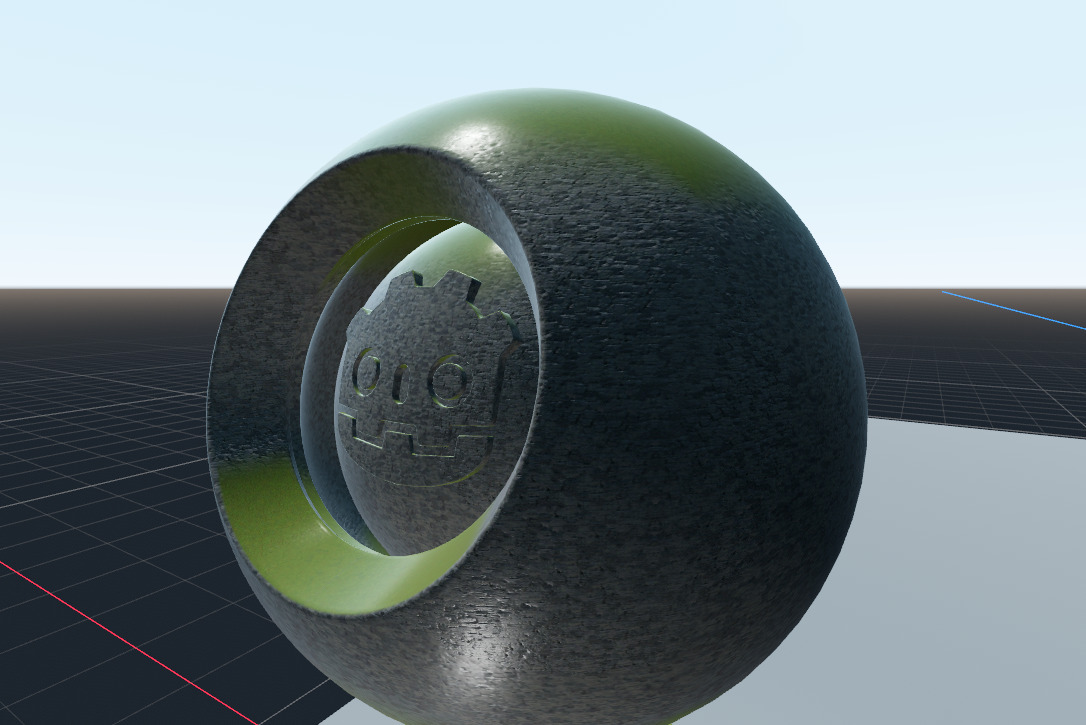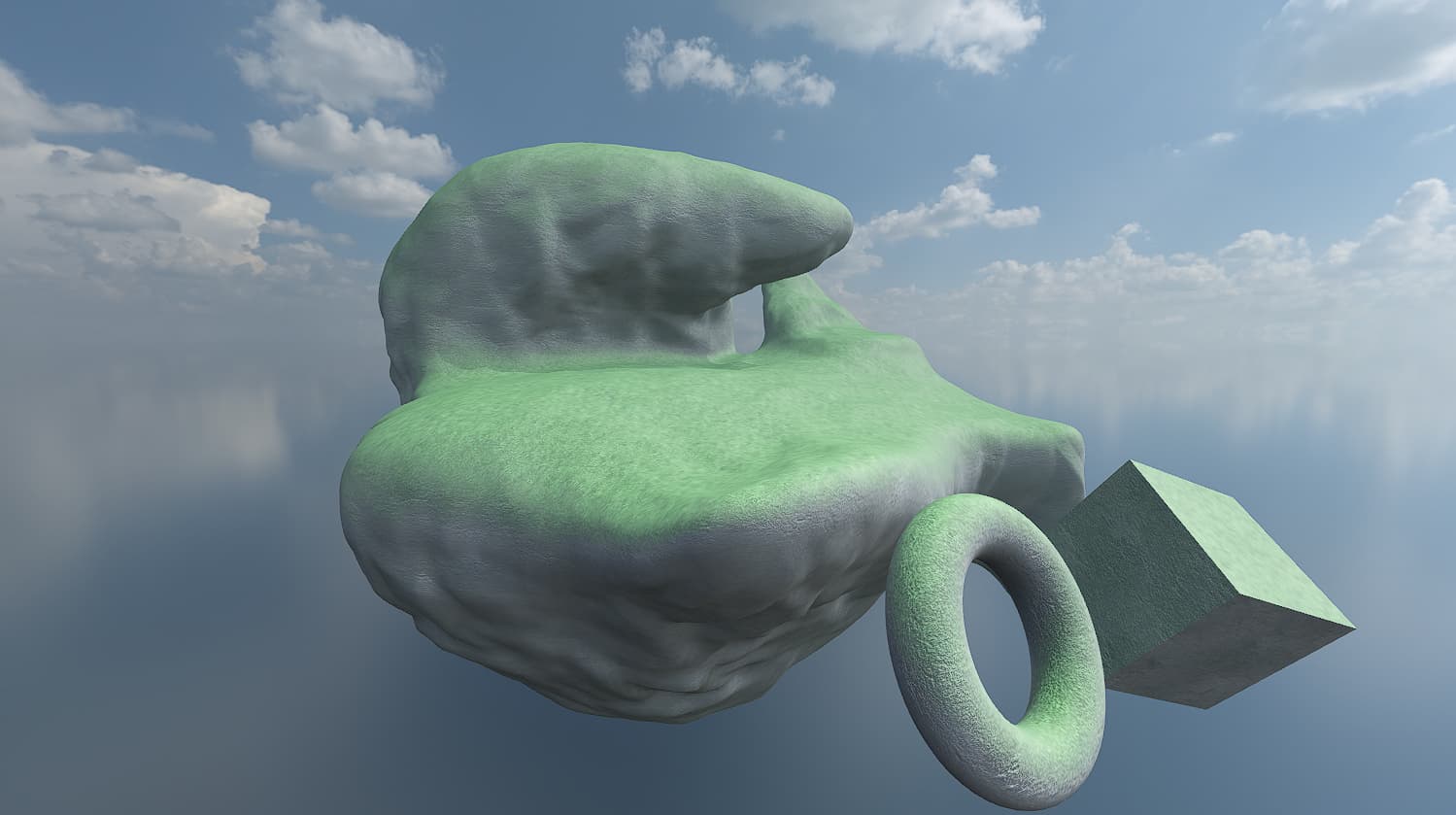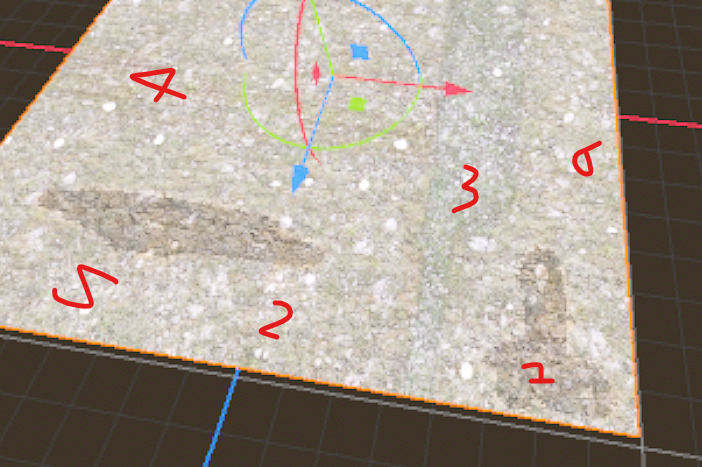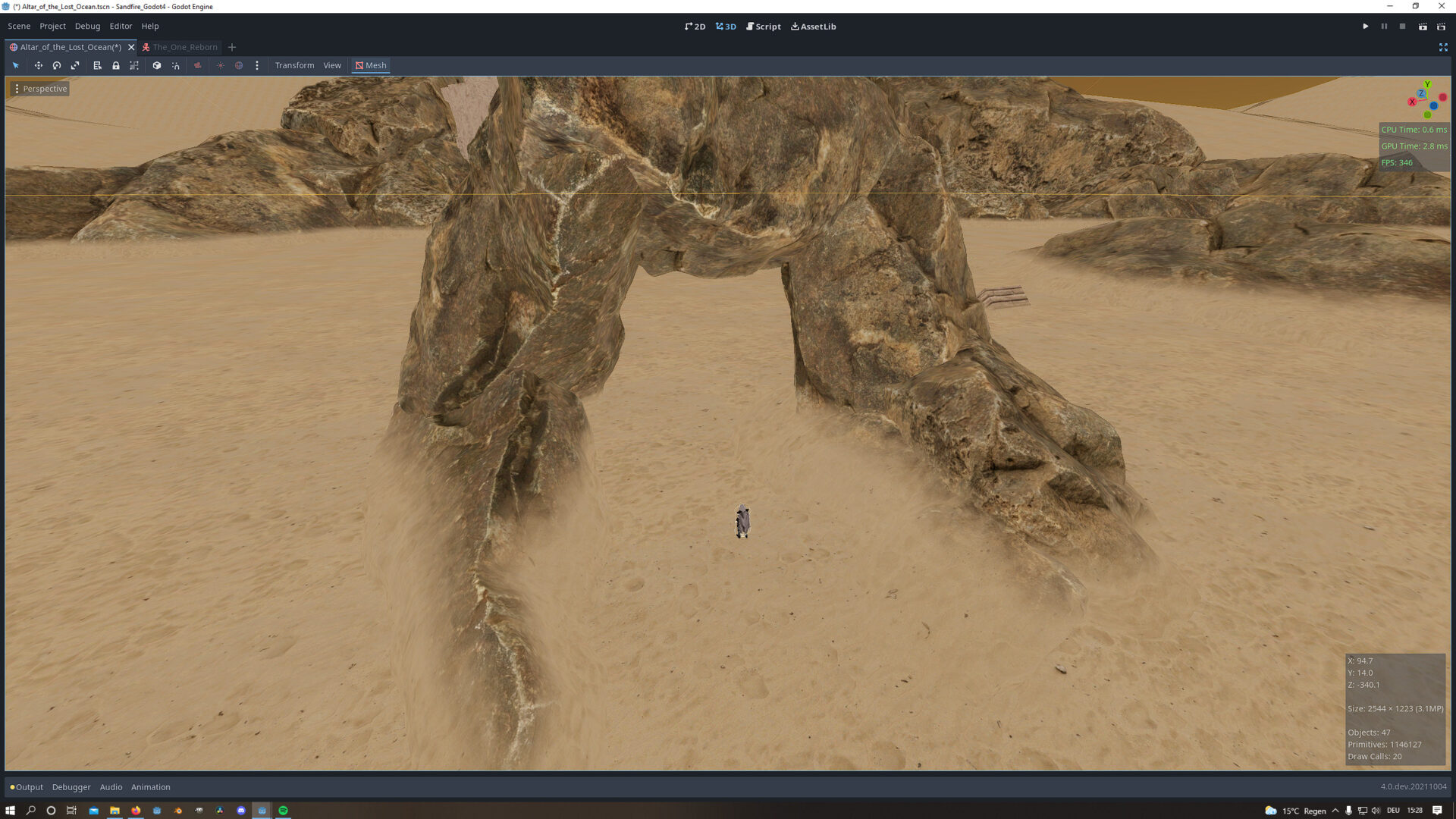Hextiling triplanar terrain
Based on hextiling code in HLSL, this code provides a seamless triplanar mapped terrain shader where no seams or tiling is ever noticeable.
This shader is quite expensive, uses six samplers a total of nine times each. Woops! The advantage this one has over stochastic mapping is that this one doesn’t require any special setup.
Please, tell me if you have any issues with it or if you see any part that could be optimized
Currently works for Godot 3.5, might perform better on vulkan.
Shader code
//MIT License
//
//Copyright (c) 2022 mmikk, yaelatletl
//
//Permission is hereby granted, free of charge, to any person obtaining a copy
//of this software and associated documentation files (the "Software"), to deal
//in the Software without restriction, including without limitation the rights
//to use, copy, modify, merge, publish, distribute, sublicense, and/or sell
//copies of the Software, and to permit persons to whom the Software is
//furnished to do so, subject to the following conditions:
//
//The above copyright notice and this permission notice shall be included in all
//copies or substantial portions of the Software.
//
//THE SOFTWARE IS PROVIDED "AS IS", WITHOUT WARRANTY OF ANY KIND, EXPRESS OR
//IMPLIED, INCLUDING BUT NOT LIMITED TO THE WARRANTIES OF MERCHANTABILITY,
//FITNESS FOR A PARTICULAR PURPOSE AND NONINFRINGEMENT. IN NO EVENT SHALL THE
//AUTHORS OR COPYRIGHT HOLDERS BE LIABLE FOR ANY CLAIM, DAMAGES OR OTHER
//LIABILITY, WHETHER IN AN ACTION OF CONTRACT, TORT OR OTHERWISE, ARISING FROM,
//OUT OF OR IN CONNECTION WITH THE SOFTWARE OR THE USE OR OTHER DEALINGS IN THE
//SOFTWARE.
//Hextiling terrain shader for Godot Engine, based on: https://github.com/mmikk/hextile-demo
//ported from HLSL by Yael Atletl
shader_type spatial;
render_mode blend_mix;
const float FLT_EPSILON = 1.192092896e-07F;
const float M_PI = 3.141592;
uniform sampler2D top_base_color : hint_albedo;
uniform sampler2D top_normal_map : hint_normal;
uniform sampler2D top_ORM : hint_white;
//uniform sampler2D top_displace: hint_white;
uniform sampler2D side_base_color : hint_albedo;
uniform sampler2D side_normal_map : hint_normal;
uniform sampler2D side_ORM : hint_white;
//uniform sampler2D side_displace : hint_white;
uniform float metallic = 0.0;
uniform float roughness = 0.0;
uniform float light_affect = 0.0;
uniform float uv1_blend_sharpness;
uniform vec3 uv1_scale;
uniform vec3 uv1_offset;
uniform vec3 uv2_scale;
uniform vec3 uv2_offset;
uniform float sides_smoothing = 0.25;
uniform float top_smoothing = 0.35;
varying vec3 uv1_power_normal;
varying vec3 sigmaX;
varying vec3 sigmaY;
varying vec3 nrmBaseNormal;
varying vec3 dPdx;
varying vec3 dPdy;
varying float flip_sign;
// Used for vertex-level tangent space (one UV set only).
varying vec3 mikktsTangent;
varying vec3 mikktsBitangent;
varying vec3 uv1_triplanar_pos;
vec2 frac(vec2 texin){
return vec2(texin.x - floor(texin.x), texin.y-floor(texin.y));
}
vec3 ResolveNormalFromSurfaceGradient(vec3 surfGrad)
{
return normalize(nrmBaseNormal - surfGrad);
}
// Input: vM is tangent space normal in [-1;1].
// Output: convert vM to a derivative.
vec2 TspaceNormalToDerivative(vec3 vM)
{
const float scale = 1.0/128.0;
// Ensure vM delivers a positive third component using abs() and
// constrain vM.z so the range of the derivative is [-128; 128].
vec3 vMa = abs(vM);
float z_ma = max(vMa.z, scale*max(vMa.x, vMa.y));
// Set to match positive vertical texture coordinate axis.
const bool gFlipVertDeriv = true;
const float s = gFlipVertDeriv ? -1.0 : 1.0;
return -vec2(vM.x, s*vM.y)/z_ma;
}
vec3 SurfgradFromTBN(vec2 deriv, vec3 vT, vec3 vB)
{
return deriv.x*vT + deriv.y*vB;
}
void GenBasisTB(out vec3 vT, out vec3 vB, vec2 texST)
{
vec2 dSTdx = dFdx(texST);
vec2 dSTdy = dFdy(texST);
float det = dot(dSTdx, vec2(dSTdy.y, -dSTdy.x));
float sign_det = det < 0.0 ? -1.0 : 1.0;
// invC0 represents (dXds, dYds), but we don't divide
// by the determinant. Instead, we scale by the sign.
vec2 invC0 = sign_det*vec2(dSTdy.y, -dSTdx.y);
vT = sigmaX*invC0.x + sigmaY*invC0.y;
if (abs(det) > 0.0) vT = normalize(vT);
vB = (sign_det*flip_sign)*cross(nrmBaseNormal, vT);
}
// Surface gradient from a known "normal" such as from an object-
// space normal map. This allows us to mix the contribution with
// others, including from tangent-space normals. The vector v
// doesn't need to be unit length so long as it establishes
// the direction. It must also be in the same space as the normal.
vec3 SurfgradFromPerturbedNormal(vec3 v)
{
// If k is negative then we have an inward facing vector v,
// so we negate the surface gradient to perturb toward v.
vec3 n = nrmBaseNormal;
float k = dot(n, v);
return (k*n - v)/max(FLT_EPSILON, abs(k));
}
// dim: resolution of the texture deriv was sampled from.
// isDerivScreenSpace: true if deriv is already in screen space.
vec3 SurfgradScaleDependent(vec2 deriv, vec2 texST, ivec2 dim, bool isDerivScreenSpace) //= false
{
// Convert derivative to normalized (s,t) space.
const vec2 dHdST = vec2(dim)*deriv;
// Convert derivative to screen space by applying
// the chain rule. dHdx and dHdy correspond to
// dFdx_fine(height) and dFdy_fine(height).
vec2 texDx = dFdx(texST);
vec2 texDy = dFdy(texST);
float dHdx = dHdST.x*texDx.x + dHdST.y*texDx.y;
float dHdy = dHdST.x*texDy.x + dHdST.y*texDy.y;
if (isDerivScreenSpace)
{
dHdx = deriv.x;
dHdy = deriv.y;
}
// Eq.3 in "Bump Mapping Unparametrized Surfaces on the GPU".
vec3 vR1 = cross(dPdy, nrmBaseNormal);
vec3 vR2 = cross(nrmBaseNormal, dPdx);
float det = dot(dPdx, vR1);
const float eps = 1.192093e-15F;
float sign_det = det < 0.0 ? -1.0 : 1.0;
float s = sign_det/max(eps, abs(det));
return s*(dHdx*vR1 + dHdy*vR2);
}
// Used to produce a surface gradient from the gradient of a volume
// bump function such as 3D Perlin noise. Equation 2 in [Mik10].
vec3 SurfgradFromVolumeGradient(vec3 grad)
{
return grad - dot(nrmBaseNormal, grad)*nrmBaseNormal;
}
// Triplanar projection is considered a special case of volume
// bump map. Weights are obtained using DetermineTriplanarWeights()
// and derivatives using TspaceNormalToDerivative().
vec3 SurfgradFromTriplanarProjection(vec3 triplanarWeights, vec2 deriv_xplane, vec2 deriv_yplane, vec2 deriv_zplane)
{
const float w0 = triplanarWeights.x;
const float w1 = triplanarWeights.y;
const float w2 = triplanarWeights.z;
// Assume deriv_xplane, deriv_yplane, and deriv_zplane are
// sampled using (z,y), (x,z), and (x,y), respectively.
// Positive scales of the lookup coordinate will work
// as well, but for negative scales the derivative components
// will need to be negated accordingly.
vec3 grad = vec3(w2*deriv_zplane.x + w1*deriv_yplane.x,
w2*deriv_zplane.y + w0*deriv_xplane.y,
w0*deriv_xplane.x + w1*deriv_yplane.y);
return SurfgradFromVolumeGradient(grad);
}
// Adapted from
// http://www.slideshare.net/icastano/cascades-demo-secrets.
vec3 DetermineTriplanarWeights(float k )//= 3.0
{
vec3 weights = abs(nrmBaseNormal) - 0.2;
weights = max(weights, 0);
weights = pow(weights, vec3(k));
weights /= (weights.x + weights.y + weights.z);
return weights;
}
float CalculateLevelOfDetail(){ //samp, texST
return 1.0;
}
// Returns dHduv where (u,v) is in pixel units at the top MIP level.
vec2 DerivFromHeightMap(sampler2D samp, vec2 texST, bool isUpscaleHQ) // = false
{
float lod = CalculateLevelOfDetail();
ivec2 dim = textureSize(samp, int(lod));
vec2 onePixOffs = vec2(1.0/float(dim.x), 1.0/float(dim.y));
float eoffs = exp2(lod);
vec2 actualOffs = onePixOffs*eoffs;
vec2 st_r = texST + vec2(actualOffs.x, 0.0);
vec2 st_u = texST + vec2(0.0, actualOffs.y);
float Hr = texture(samp, st_r).x;
float Hu = texture(samp, st_u).x;
float Hc = texture(samp, texST).x;
vec2 dHduv = vec2(Hr - Hc, Hu - Hc)/eoffs;
float start = 0.5, end = 0.05; // start-end fade
float mixd = clamp((lod - start)/(end - start), 0.0, 1.0);
if (isUpscaleHQ && mixd > 0.0)
{
vec2 f2TexCoord = vec2(dim)*texST - vec2(0.5, 0.5);
vec2 f2FlTexCoord = floor(f2TexCoord);
vec2 t = clamp(f2TexCoord - f2FlTexCoord, 0.0, 1.0);
vec2 cenST = (f2FlTexCoord + vec2(0.5, 0.5))/vec2(dim);
vec4 sampUL = texelFetch(samp, ivec2(cenST + vec2(-1,-1)), int(lod));
vec4 sampUR = texelFetch(samp, ivec2(cenST + vec2( 1,-1)), int(lod));
vec4 sampLL = texelFetch(samp, ivec2(cenST + vec2(-1, 1)), int(lod));
vec4 sampLR = texelFetch(samp, ivec2(cenST + vec2( 1, 1)), int(lod));
// vec4(UL.wz, UR.wz) represents first scanline and so on.
mat4 H = mat4(
vec4(sampUL.w, sampUL.z, sampUR.w, sampUR.z),
vec4(sampUL.x, sampUL.y, sampUR.x, sampUR.y),
vec4(sampLL.w, sampLL.z, sampLR.w, sampLR.z),
vec4(sampLL.x, sampLL.y, sampLR.x, sampLR.y));
vec2 A = vec2(1.0 - t.x, t.x);
vec2 B = vec2(1.0 - t.y, t.y);
vec4 X = 0.25*vec4(A.x, 2.0*A.x + A.y, A.x + 2.0*A.y, A.y);
vec4 Y = 0.25*vec4(B.x, 2.0*B.x + B.y, B.x + 2.0*B.y, B.y);
vec4 dX = 0.5*vec4(-A.x, -A.y, A.x, A.y);
vec4 dY = 0.5*vec4(-B.x, -B.y, B.x, B.y);
vec2 dHduv_ups = vec2(dot( Y, H*dX), dot(dY, H*X));
dHduv = mix(dHduv, dHduv_ups, mixd);
}
return dHduv;
}
// Returns dHduv where (u,v) is in pixel units at the top MIP level.
vec2 DerivFromHeightMapLevel(sampler2D samp, vec2 texST, float lod_in, bool isUpscaleHQ) //=false
{
ivec2 dim = textureSize(samp, int(CalculateLevelOfDetail()));
vec2 onePixOffs = vec2(1.0/float(dim.x), 1.0/float(dim.y));
float lod = max(0.0, lod_in);
float eoffs = exp2(lod);
vec2 actualOffs = onePixOffs*eoffs;
vec2 st_r = texST + vec2(actualOffs.x, 0.0);
vec2 st_u = texST + vec2(0.0, actualOffs.y);
float Hr = textureLod(samp, st_r, lod).x;
float Hu = textureLod(samp, st_u, lod).x;
float Hc = textureLod(samp, texST, lod).x;
vec2 dHduv = vec2(Hr - Hc, Hu - Hc)/eoffs;
float start = 0.5, end = 0.05; // start-end fade
float mixd = clamp((lod - start)/(end - start), 0.0, 1.0);
if (isUpscaleHQ && mixd > 0.0)
{
vec2 f2TexCoord = vec2(dim)*texST - vec2(0.5, 0.5);
vec2 f2FlTexCoord = floor(f2TexCoord);
vec2 t = clamp(f2TexCoord - f2FlTexCoord, 0.0, 1.0);
vec2 cenST = (f2FlTexCoord + vec2(0.5, 0.5))/vec2(dim);
vec4 sampUL = texelFetch(samp, ivec2(cenST+ vec2(-1,-1)), 1);
vec4 sampUR = texelFetch(samp, ivec2(cenST+ vec2( 1,-1)), 1);
vec4 sampLL = texelFetch(samp, ivec2(cenST+ vec2(-1, 1)), 1);
vec4 sampLR = texelFetch(samp, ivec2(cenST+ vec2( 1, 1)), 1);
// vec4(UL.wz, UR.wz) represents first scanline and so on.
mat4 H = mat4(
vec4(sampUL.w, sampUL.z, sampUR.w, sampUR.z),
vec4(sampUL.x, sampUL.y, sampUR.x, sampUR.y),
vec4(sampLL.w, sampLL.z, sampLR.w, sampLR.z),
vec4(sampLL.x, sampLL.y, sampLR.x, sampLR.y));
vec2 A = vec2(1.0 - t.x, t.x);
vec2 B = vec2(1.0 - t.y, t.y);
vec4 X = 0.25*vec4(A.x, 2.0*A.x + A.y, A.x + 2.0*A.y, A.y);
vec4 Y = 0.25*vec4(B.x, 2.0*B.x + B.y, B.x + 2.0*B.y, B.y);
vec4 dX = 0.5*vec4(-A.x, -A.y, A.x, A.y);
vec4 dY = 0.5*vec4(-B.x, -B.y, B.x, B.y);
vec2 dHduv_ups = vec2(dot( Y, H*dX), dot(dY, H*X));
dHduv = mix(dHduv, dHduv_ups, mixd);
}
return dHduv;
}
// fix backward facing normal
vec3 FixNormal(vec3 N, vec3 V)
{
return dot(N,V)>=0.0 ? N : (N-2.0*dot(N,V)*V);
}
// dir: normalized vector in same space as surface pos and normal.
// bumpScale: p' = p + bumpScale*DisplacementMap(s,t)*normal.
vec2 ProjectVecToTextureSpace(vec3 dir, vec2 texST, float bumpScale, bool skipProj) // = false
{
vec2 texDx = dFdx(texST);
vec2 texDy = dFdy(texST);
vec3 vR1 = cross(dPdy, nrmBaseNormal);
vec3 vR2 = cross(nrmBaseNormal, dPdx);
float det = dot(dPdx, vR1);
const float eps = 1.192093e-15F;
float sgn = det < 0.0 ? -1.0 : 1.0;
float s = sgn/max(eps, abs(det));
vec2 dirScr = s*vec2(dot(vR1, dir), dot(vR2, dir));
vec2 dirTex = texDx*dirScr.x + texDy*dirScr.y;
float dirTexZ = dot(nrmBaseNormal, dir);
// To search heights in [0;1] range use dirTex.xy/dirTexZ.
s = skipProj ? 1.0 : 1.0/max(FLT_EPSILON, abs(dirTexZ));
return s*bumpScale*dirTex;
}
// initialST: initial texture coordinate before parallax correction.
// corrOffs: parallax-corrected offset from initialST.
vec3 TexSpaceOffsToSurface(vec2 initialST, vec2 corrOffs)
{
vec2 texDx = dFdx(initialST);
vec2 texDy = dFdy(initialST);
float det = texDx.x*texDy.y - texDx.y*texDy.x;
const float eps = 1.192093e-15F;
float sgn = det < 0.0 ? -1.0 : 1.0;
float s = sgn/max(eps, abs(det));
// Transform corrOffs from texture space to screen space.
// Use 2x2 inverse of [dFdx(initialST) | dFdy(initialST)]
float vx = s*( texDy.y*corrOffs.x - texDy.x*corrOffs.y);
float vy = s*(-texDx.y*corrOffs.x + texDx.x*corrOffs.y);
// Transform screen-space vector to the surface.
return vx*sigmaX + vy*sigmaY;
}
uniform float g_fallOffContrast = 0.6;
uniform float g_exp = 7;
// Output:\ weights associated with each hex tile and integer centers
void TriangleGrid(out float w1, out float w2, out float w3,
out ivec2 vertex1, out ivec2 vertex2, out ivec2 vertex3,
vec2 st)
{
// Scaling of the input
st *= 2.0 * sqrt(3);
// Skew input space into simplex triangle grid
const mat2 gridToSkewedGrid =
mat2(vec2(1.0, -0.57735027), vec2( 0.0, 1.15470054));
vec2 skewedCoord = gridToSkewedGrid*st;
ivec2 baseId = ivec2( floor ( skewedCoord ));
vec3 temp = vec3( frac( skewedCoord ), 0);
temp.z = 1.0 - temp.x - temp.y;
float s = step(0.0, -temp.z);
float s2 = 2.0*s-1.0;
w1 = -temp.z*s2;
w2 = s - temp.y*s2;
w3 = s - temp.x*s2;
vertex1 = baseId + ivec2(int(s));
vertex2 = baseId + ivec2(int(s),int(1.0-s));
vertex3 = baseId + ivec2(int(1.0-s),int(s));
}
float fmod(float x, float y){
return x - y * trunc(x/y);
}
vec2 hash(ivec2 p)
{
vec2 r = mat2(vec2(127.1, 311.7),vec2(269.5, 183.3))*vec2(p);
return frac( sin( r )*43758.5453 );
}
vec2 sampleDeriv(sampler2D samp, vec2 st, vec2 dSTdx, vec2 dSTdy)
{
// sample
vec3 vM = 2.0*textureGrad(samp, st, dSTdx, dSTdy).rgb-1.0;
return TspaceNormalToDerivative(vM);
}
mat2 LoadRot2x2(ivec2 idx, float rotStrength)
{
float angle = float(abs(idx.x*idx.y)) + float(abs(idx.x+idx.y)) + M_PI;
// remap to +/-pi
angle = fmod(angle, 2.0*M_PI);
if(angle<0.0) angle += 2.0*M_PI;
if(angle>M_PI) angle -= 2.0*M_PI;
angle *= rotStrength;
float cs = cos(angle), si = sin(angle);
return mat2(vec2(cs, -si),vec2(si, cs));
}
vec2 MakeCenST(ivec2 Vertex)
{
mat2 invSkewMat = mat2(vec2(1.0, 0.5), vec2(0.0, 1.0/1.15470054));
return (invSkewMat * vec2(Vertex)) / (2.0 * sqrt(3.0));
}
vec3 Gain3(vec3 x, float r)
{
// increase contrast when r>0.5 and
// reduce contrast if less
float k = log(1.0-r) / log(0.5);
vec3 s = 2.0*step(0.5, x);
vec3 m = 2.0*(1.0 - s);
vec3 res = 0.5*s + 0.25*m * pow(max(vec3(0.0), s + x*m), vec3(k));
return res.xyz / (res.x+res.y+res.z);
}
vec3 ProduceHexWeights(vec3 W, ivec2 vertex1, ivec2 vertex2, ivec2 vertex3)
{
vec3 res = vec3(0.0);
int v1 = (vertex1.x-vertex1.y)%3;
if(v1<0) v1+=3;
int vh = v1<2 ? (v1+1) : 0;
int vl = v1>0 ? (v1-1) : 2;
int v2 = vertex1.x<vertex3.x ? vl : vh;
int v3 = vertex1.x<vertex3.x ? vh : vl;
res.x = v3==0 ? W.z : (v2==0 ? W.y : W.x);
res.y = v3==1 ? W.z : (v2==1 ? W.y : W.x);
res.z = v3==2 ? W.z : (v2==2 ? W.y : W.x);
return res;
}
// Input:\ nmap is a normal map
// Input:\ r increase contrast when r>0.5
// Output:\ deriv is a derivative dHduv wrt units in pixels
// Output:\ weights shows the weight of each hex tile
void bumphex2derivNMap(out vec2 deriv, out vec3 weights,
sampler2D samp, vec2 st,
float rotStrength, float r) //=0.5
{
vec2 dSTdx = dFdx(st);
vec2 dSTdy = dFdy(st);
// Get triangle info
float w1, w2, w3;
ivec2 vertex1, vertex2, vertex3;
TriangleGrid(w1, w2, w3, vertex1, vertex2, vertex3, st);
mat2 rot1 = LoadRot2x2(vertex1, rotStrength);
mat2 rot2 = LoadRot2x2(vertex2, rotStrength);
mat2 rot3 = LoadRot2x2(vertex3, rotStrength);
vec2 cen1 = MakeCenST(vertex1);
vec2 cen2 = MakeCenST(vertex2);
vec2 cen3 = MakeCenST(vertex3);
vec2 st1 = (st - cen1)* rot1 + cen1 + hash(vertex1);
vec2 st2 = (st - cen2)* rot2 + cen2 + hash(vertex2);
vec2 st3 = (st - cen3)* rot3 + cen3 + hash(vertex3);
// Fetch input
vec2 d1 = sampleDeriv(samp, st1,
(dSTdx* rot1), (dSTdy* rot1));
vec2 d2 = sampleDeriv(samp, st2,
(dSTdx* rot2), (dSTdy* rot2));
vec2 d3 = sampleDeriv(samp, st3,
(dSTdx* rot3), (dSTdy* rot3));
d1 = (rot1* d1); d2 = (rot2* d2); d3 = (rot3* d3);
// produce sine to the angle between the conceptual normal
// in tangent space and the Z-axis
vec3 D = vec3( dot(d1,d1), dot(d2,d2), dot(d3,d3));
vec3 Dw = sqrt(D/(1.0+D));
Dw = mix(vec3(1.0), Dw, g_fallOffContrast); // 0.6
vec3 W = Dw*vec3(pow(w1,g_exp), pow(w2,g_exp), pow(w3, g_exp)); // 7
W /= (W.x+W.y+W.z);
if(r!=0.5) W = Gain3(W, r);
deriv = W.x * d1 + W.y * d2 + W.z * d3;
weights = ProduceHexWeights(W.xyz, vertex1, vertex2, vertex3);
}
// Input:\ tex is a texture with color
// Input:\ r increase contrast when r>0.5
// Output:\ color is the blended result
// Output:\ weights shows the weight of each hex tile
void hex2colTex(out vec4 color, out vec3 weights,
sampler2D samp, vec2 st,
float rotStrength, float r)//=0.5
{
vec2 dSTdx = dFdx(st), dSTdy = dFdy(st);
// Get triangle info
float w1, w2, w3;
ivec2 vertex1, vertex2, vertex3;
TriangleGrid(w1, w2, w3, vertex1, vertex2, vertex3, st);
mat2 rot1 = LoadRot2x2(vertex1, rotStrength);
mat2 rot2 = LoadRot2x2(vertex2, rotStrength);
mat2 rot3 = LoadRot2x2(vertex3, rotStrength);
vec2 cen1 = MakeCenST(vertex1);
vec2 cen2 = MakeCenST(vertex2);
vec2 cen3 = MakeCenST(vertex3);
vec2 st1 = (st - cen1* rot1) + cen1 + hash(vertex1);
vec2 st2 = (st - cen2* rot2) + cen2 + hash(vertex2);
vec2 st3 = (st - cen3* rot3) + cen3 + hash(vertex3);
// Fetch input
vec4 c1 = textureGrad(samp, st1,
(dSTdx* rot1), (dSTdy* rot1));
vec4 c2 = textureGrad(samp, st2,
(dSTdx* rot2), (dSTdy* rot2));
vec4 c3 = textureGrad(samp, st3,
(dSTdx* rot3), (dSTdy* rot3));
// use luminance as weight
vec3 Lw = vec3(0.299, 0.587, 0.114);
vec3 Dw = vec3(dot(c1.xyz,Lw),dot(c2.xyz,Lw),dot(c3.xyz,Lw));
Dw = mix(vec3(1.0), Dw, g_fallOffContrast); // 0.6
vec3 W = Dw*pow(vec3(w1, w2, w3), vec3(g_exp)); // 7
W /= (W.x+W.y+W.z);
if(r!=0.5) W = Gain3(W, r);
color = W.x * c1 + W.y * c2 + W.z * c3;
weights = ProduceHexWeights(W.xyz, vertex1, vertex2, vertex3);
}
vec4 triplanar_texture(sampler2D top_sampler,sampler2D side_sampler,vec3 p_weights,vec3 p_triplanar_pos) {
// the following variables are left for reference
//vec3 sp = uv1_triplanar_pos; //bit of a headache, but much better than the previous method.
//vec2 st0 = vec2(sp.x, sp.z); //top coordinates
//vec2 st1 = vec2(sp.x, sp.y); //side1 coordinates
//vec2 st2 = vec2(sp.z, sp.y); //side2 coordinates
vec4 samp=vec4(0.0);
vec4 temp_samp = vec4(0.0);
vec3 weights;
hex2colTex(temp_samp, weights, top_sampler, uv1_triplanar_pos.xz, 1.0, 0.5);
//temp_samp.rgb = weights;
samp+= temp_samp* smoothstep((p_weights.z +p_weights.x-p_weights.y), 1.0, top_smoothing);
hex2colTex(temp_samp, weights, side_sampler, uv1_triplanar_pos.zy, 1.0, 0.5);
//temp_samp.rgb = weights;
samp += temp_samp *smoothstep((-p_weights.x+p_weights.z+p_weights.y), 1.0, sides_smoothing);
float eh = 10.0*(-(-p_weights.x+p_weights.z+p_weights.y)*-(p_weights.x-p_weights.z+p_weights.y))*-(p_weights.z +p_weights.x-p_weights.y);
eh = eh*float(eh<0.02); //weighting blind spots, 3d math why
hex2colTex(temp_samp, weights, side_sampler, uv1_triplanar_pos.xy, 1.0, 0.5);
//temp_samp.rgb = weights;
samp += temp_samp * smoothstep((p_weights.x-p_weights.z+p_weights.y)+eh, 1.0, sides_smoothing);
samp = normalize(samp); //normalize this additive mess
return samp;
}
//uniform float displacement_strength = 0.5;
void vertex() {
TANGENT = vec3(0.0,0.0,-1.0) * abs(NORMAL.x);
TANGENT+= vec3(1.0,0.0,0.0) * abs(NORMAL.y);
TANGENT+= vec3(1.0,0.0,0.0) * abs(NORMAL.z);
TANGENT = normalize(TANGENT);
BINORMAL = vec3(0.0,1.0,0.0) * abs(NORMAL.x);
BINORMAL+= vec3(0.0,0.0,-1.0) * abs(NORMAL.y);
BINORMAL+= vec3(0.0,1.0,0.0) * abs(NORMAL.z);
BINORMAL = normalize(BINORMAL);
uv1_power_normal=pow(abs(NORMAL),vec3(uv1_blend_sharpness));
uv1_power_normal/=dot(uv1_power_normal,vec3(1.0));
uv1_triplanar_pos = VERTEX * uv1_scale + uv1_offset;
uv1_triplanar_pos *= vec3(1.0,-1.0, 1.0);
//float displace = triplanar_texture(top_displace,side_displace,uv1_power_normal,uv1_triplanar_pos).r;
//VERTEX += NORMAL * displace * displacement_strength;
}
void fragment(){
vec4 orm = triplanar_texture(top_ORM, side_ORM, uv1_power_normal, uv1_triplanar_pos).rgba;
ALBEDO = triplanar_texture(top_base_color, side_base_color, uv1_power_normal, uv1_triplanar_pos).rgb;
NORMALMAP = triplanar_texture(top_normal_map, side_normal_map, uv1_power_normal, uv1_triplanar_pos).rgb;
AO = orm.r *light_affect;
ROUGHNESS = orm.g * roughness;
METALLIC = orm.b * metallic;
SPECULAR = 0.5 - clamp(1.0-orm.r, 0.0, 0.5);
}







